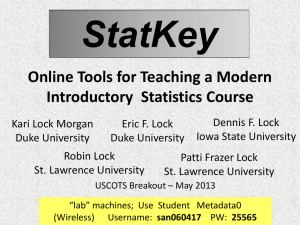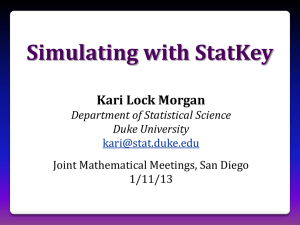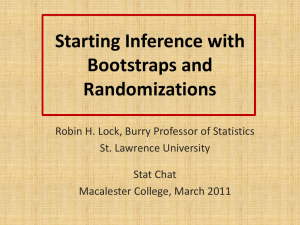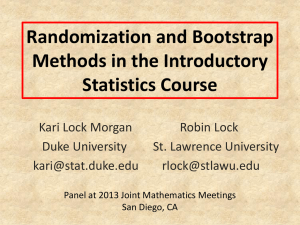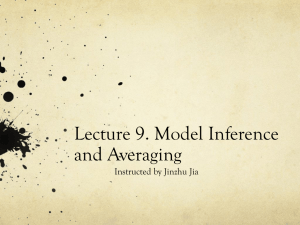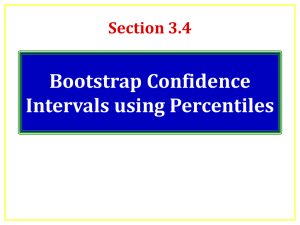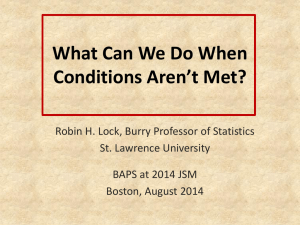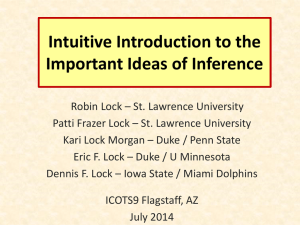Document
advertisement
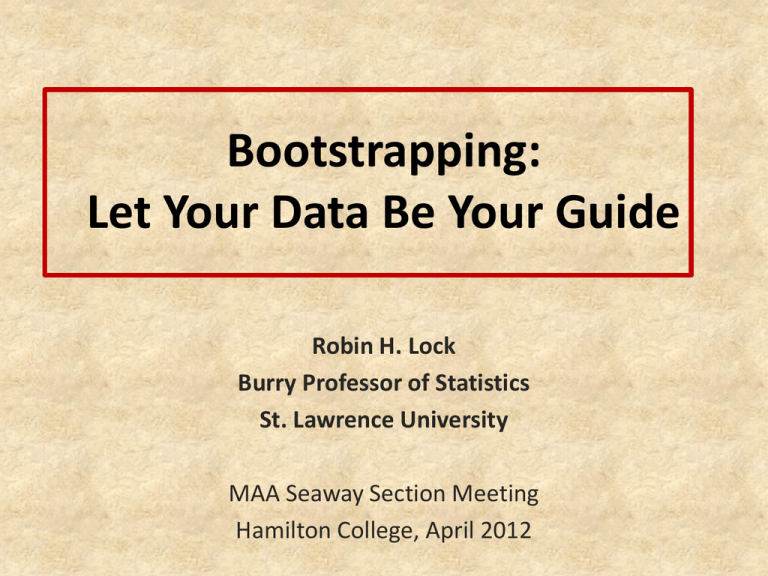
Bootstrapping: Let Your Data Be Your Guide Robin H. Lock Burry Professor of Statistics St. Lawrence University MAA Seaway Section Meeting Hamilton College, April 2012 Questions to Address • What is bootstrapping? • How/why does it work? • Can it be made accessible to intro statistics students? • Can it be used as the way to introduce students to key ideas of statistical inference? The Lock5 Team Dennis St. Lawrence Iowa State Robin SUNY Oneonta St. Lawrence Patti Colgate St. Lawrence Kari Williams Harvard Duke Eric Hamilton UNC- Chapel Hill Quick Review: Confidence Interval for a Mean 𝑠 ∗ 𝑥±𝑡 𝑛 Estimate ± Margin of Error Estimate ± (Table)*(Standard Error) What’s the “right” table? How do we estimate the standard error? Common Difficulties Example: Suppose n=15 and the underlying population is skewed with outliers? t-distribution doesn’t apply Example: Find a confidence interval for the standard deviation in a population. 𝑠 ± ?? What is the distribution? What is the standard error for s? Traditional Approach: Sampling Distributions Take LOTS of samples (size n) from the population and compute the statistic of interest for each sample. • Recognize the form of the distribution • Estimate the standard error of the statistic BUT, in practice, is it feasible to take lots of samples from the population? What can we do if we ONLY have one sample? Alternate Approach: Bootstrapping “Let your data be your guide.” Brad Efron – Stanford University “Bootstrap” Samples Key idea: Sample with replacement from the original sample using the same n. Assumes the “population” is many, many copies of the original sample. Purpose: See how a sample statistic, like 𝑥, based on samples of the same size tends to vary from sample to sample. Suppose we have a random sample of 6 people: Original Sample A simulated “population” to sample from Bootstrap Sample: Sample with replacement from the original sample, using the same sample size. Original Sample Bootstrap Sample Example: Atlanta Commutes What’s the mean commute time for workers in metropolitan Atlanta? Data: The American Housing Survey (AHS) collected data from Atlanta in 2004. Sample of n=500 Atlanta Commutes CommuteAtlanta Dot Plot n = 500 𝑥 =29.11 minutes s = 20.72 minutes 20 40 60 80 100 120 140 160 Time Where is the “true” mean (µ)? 180 Original Sample Sample Statistic Bootstrap Sample Bootstrap Statistic Bootstrap Sample Bootstrap Statistic . . . Bootstrap Sample . . . Bootstrap Statistic Bootstrap Distribution We need technology! StatKey www.lock5stat.com StatKey One to Many Samples Three Distributions How can we get a confidence interval from a bootstrap distribution? Method #1: Use the standard deviation of the bootstrap statistics as a “yardstick” Using the Bootstrap Distribution to Get a Confidence Interval – Version #1 The standard deviation of the bootstrap statistics estimates the standard error of the sample statistic. Quick interval estimate : 𝑂𝑟𝑖𝑔𝑖𝑛𝑎𝑙 𝑆𝑡𝑎𝑡𝑖𝑠𝑡𝑖𝑐 ± 2 ∙ 𝑆𝐸 For the mean Atlanta commute time: 29.11 ± 2 ∙ 0.92 = 29.11 ± 1.84 = (27.27, 30.95) Using the Bootstrap Distribution to Get a Confidence Interval – Version #2 95% CI=(27.35,30.96) Chop 2.5% in each tail Keep 95% in middle Chop 2.5% in each tail For a 95% CI, find the 2.5%-tile and 97.5%-tile in the bootstrap distribution 90% CI for Mean Atlanta Commute 90% CI=(27.64,30.65) Chop 5% in each tail Keep 90% in middle Chop 5% in each tail For a 90% CI, find the 5%-tile and 95%-tile in the bootstrap distribution Bootstrap Confidence Intervals Version 1 (Statistic 2 SE): Great preparation for moving to traditional methods Version 2 (Percentiles): Great at building understanding of confidence intervals Sampling Distribution Population BUT, in practice we don’t see the “tree” or all of the “seeds” – we only have ONE seed µ Bootstrap Distribution What can we do with just one seed? Bootstrap “Population” Estimate the distribution and variability (SE) of 𝑥’s from the bootstraps Grow a NEW tree! 𝑥 µ Golden Rule of Bootstraps The bootstrap statistics are to the original statistic as the original statistic is to the population parameter. What about Other Parameters? Estimate the standard error and/or a confidence interval for... • proportion (𝑝) • difference in means (µ1 − µ2 ) • difference in proportions (𝑝1 − 𝑝2 ) • standard deviation (𝜎) • correlation (𝜌) Generate samples with replacement • slope (𝛽) Calculate sample statistic • ... Repeat... Example: Proportion of Home Wins in 70 Soccer, 𝑝 = = 0.583 120 Example: Difference in Mean Hours of Exercise per Week, by Gender Example: Standard Deviation of Mustang Prices Example: Find a 95% confidence interval for the correlation between size of bill and tips at a restaurant. Data: n=157 bills at First Crush Bistro (Potsdam, NY) r=0.915 Bootstrap correlations 0.055 0.041 𝑟 = 0.915 95% (percentile) interval for correlation is (0.860, 0.956) BUT, this is not symmetric… Method #3: Reverse Percentiles Golden rule of bootstraps: Bootstrap statistics are to the original statistic as the original statistic is to the population parameter. 0.055 0.041 𝒓 = 𝟎. 𝟗𝟏𝟓 𝐿𝑜𝑤𝑒𝑟 𝑏𝑜𝑢𝑛𝑑 = 0.915 − 0.041 = 0.874 𝑈𝑝𝑝𝑒𝑟 𝑏𝑜𝑢𝑛𝑑 = 0.915 + 0.055 = 0.970 Even Fancier Adjustments... Bias-Corrected Accelerated (BCa): Adjusts percentiles to account for bias and skewness in the bootstrap distribution Other methods: ABC intervals (Approximate Bootstrap Confidence) Bootstrap tilting These are generally implemented in statistical software (e.g. R) Bootstrap CI’s are NOT Foolproof Example: Find a bootstrap distribution for the median price of Mustangs, based on a sample of 25 cars at online sites. Always plot your bootstraps! What About Resampling Methods in Hypothesis Tests? “Randomization” Samples Key idea: Generate samples that are (a) based on the original sample AND (a) consistent with some null hypothesis. Example: Mean Body Temperature Is the average body temperature really 98.6oF? H0:μ=98.6 Ha:μ≠98.6 Data: A sample of n=50 body temperatures. BodyTemp50 n = 50 How unusual is 𝑥=98.26 when μ is 𝑥 =98.26 really 98.6? s = 0.765 96 97 98 99 BodyTemp Dot Plot 100 Data from Allen Shoemaker, 1996 JSE data set article 101 Randomization Samples How to simulate samples of body temperatures to be consistent with H0: μ=98.6? 1. Add 0.34 to each temperature in the sample (to get the mean up to 98.6). 2. Sample (with replacement) from the new data. 3. Find the mean for each sample (H0 is true). 4. See how many of the sample means are as extreme as the observed 𝑥 =98.26. StatKey Demo Randomization Distribution 𝑥 =98.26 p-value ≈ 1/1000 x 2 = 0.002 Connecting CI’s and Tests Measures from Sample of BodyTemp50 Dot Plot Randomization body temp means when μ=98.6 98.2 98.3 98.4 98.5 Measures from Sample of BodyTemp50 98.6 xbar 98.7 98.8 98.9 99.0 Dot Plot Bootstrap body temp means from the original sample 97.9 98.0 98.1 98.2 98.3 98.4 bootxbar 98.5 98.6 98.7 Fathom Demo Fathom Demo: Test & CI Sample mean is in the “rejection region” ⟺ Null mean is outside the confidence interval “... despite broad acceptance and rapid growth in enrollments, the consensus curriculum is still an unwitting prisoner of history. What we teach is largely the technical machinery of numerical approximations based on the normal distribution and its many subsidiary cogs. This machinery was once necessary, because the conceptually simpler alternative based on permutations was computationally beyond our reach. Before computers statisticians had no choice. These days we have no excuse. Randomization-based inference makes a direct connection between data production and the logic of inference that deserves to be at the core of every introductory course.” -- Professor George Cobb, 2007 Materials for Teaching Bootstrap/Randomization Methods? www.lock5stat.com rlock@stlawu.edu
